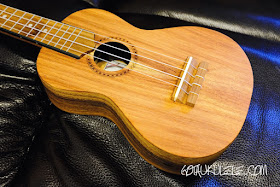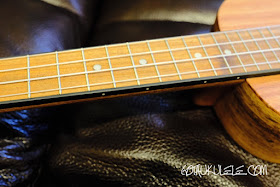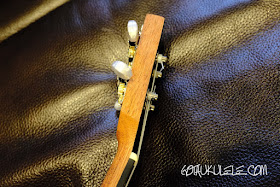Another first for Got A Ukulele with a European brand not featured before. This is the SS model Soprano from APC instruments of Portugal.
It's actually a brand I have seen around for about as long as I have been writing this website, but it's always been one that has confused me. One obvious reason for that is the naming convention, though that may just be a 'different markets' thing. You see, APC is the same brand as the ukuleles put out under the name Antonio Carvalho. In fact they are the same instruments. Yet i've not yet really seen a pattern as to why they exist as distinct lines as you can buy both in the UK! Saying that, another confusing thing is that I find that different stores list the same ukuleles and they all look different from each other despite keeping the same name! So it may be you have seen (or own) an SS ukulele like this which looks very different. Makes my job much harder than it should be!
APC stands for Antonio Pinto Carvalho, and he is the Portuguese chap who set up the APC instruments brand in the mid 1970's making a range of traditional instruments including ukuleles but also guitars, cavaquinho's and many others. I actually struggle to find out much more about them, hence my reference to confusion above. They bill themselves as 'luthiers' though I suspect they are more 'factory' than that. I could be wrong and no doubt people can correct me, but one thing is for sure - these are not made by one guy in a small workshop. They just don't seem to be very open with their background and that confusion continues into some other areas I mention below.
This SS model soprano is a very traditional looking instrument made from all solid tonewoods. And the next point of confusion comes on this very point. They list this as 'solid koa', but I am not totally convinced that it is koa in the accepted sense. It's solid wood all right as you can the grain continue on the edges because the body is not edge bound, but I don't think it is right to call it 'Koa'. You see, a while back APC announced they were using something called 'Portuguese Koa'. And there is, frankly, NO SUCH THING. Koa is a Hawaiian name given to a type of acacia that grows on the Big Island. That wood is acacia, but they call the stuff grown THERE (ie Hawaii) 'Koa'. The wood here may be the same acacia, and whilst I don't know where it is grown, it won't be Hawaii when you see the price. And that means it simply ain't Koa. It's only the stuff grown on Hawaii that gets that 'name tag'. So why use the name here? Well simply because it makes it seem like something it is not, something more special than it is. They should really call it Acacia in my book. All Koa is Acacia, but not all Acacia is Koa. OK rant over. But it is solid wood though, something I was pleased to see because with some other APC instruments they have had the nerve to call sandwiches of three pieces of wood as 'sandwiched solid' - what utter nonsense. That is not solid wood in any way, and calling it a 'solid sandwich' is as deliberately misleading as calling your wood 'Portuguese Koa'... I told you this was a model of confusion... This one IS actual solid wood though.. I'll get into the actual review eventually...
This is built in a traditional double bout shape from solid woods in a very plain finish. At first glance it is pleasingly plain on the eye, but this is plain to the point of feeling and looking very unfinished. If there is an outer finish I can's spot it as this may as well be bare wood. The oil /wax /whatever they have used has been applied SO sparingly it may as well not be there at all. Still the grain looks nice on the two piece top and on the sides. On thhe flat back though, less so. Not only is the wood much paler to the point it doesn't look like Acacia at all, it comes complete with two ugly wood knots in the wood. That's never something I want to see and will be a point of weakness in the wood. Thank goodness they were not used on the top... And like the top it has virtually no finish. It's almost like one of those 'decorate yourself' ukuleles they sell for kids. Aside from a simple etched sound hole rosette there is nothing else to see here. To be fair though, aside from that lack of finish and the ugly knots it has been put together well where it counts. At least as far as I can see from the outside.
The bridge is... well... confusion here yet again. I thought it was a straight up tie bar style, but then I saw the way the strings were tied on. I then assumed it was one of those eight hole bridges where the strings loop around themselves, but no it isn't that - it's a four hole. The strings seem to go through the bar then back into the bridge where they disappear. I 'think' therefore it's a hybrid of a through body (knots inside) bridge and a tie bar. I've never seen them like this before and I don't really care for it. I can find no product specifications to tell me what it's made of, but it certainly isn't rosewood, and doesn't look like walnut either. Who knows. The saddle is straight topped and looks like bone and is really scruffy on the edges as you can see. I suppose the one thing it does have in it's favour is that the design gives a good strong break angle to the strings. Still a regular tie bar bridge can do that too.
Looking inside and I put on my 'confused hat' once again. It's generally tidy, though the braces are both the most chunky I have ever seen on a ukulele but also in places I wouldn't expect them. They are simply massive. There is bracing on the back on the upper bout and right down below the lower bout but nothing at all in the middle. Curious. Even more curious though is the fact that there are no linings at all on the joints where the sides meet the top and back. These linings are common and create a more secure joint between the three sections, so how is it being held together I am not sure. The only instrument I know which get's away with 'no traditional linings' build are the KoAloha's, but that is because they use the uni-brace to hold the instrument as one. That's not the case here, so I really wonder what is keeping it together. My 'guess' is very thick sides to create enough contact with the back and sides. How odd. I'd worry about that. Maybe i'm wrong, but other builders don't use linings just for fun..
Up to the neck, this is made of mahogany in three pieces. There is a very obvious joint at the heel and a very well hidden one at the headstock. It has a gorgeously traditional very flat profile which I really like, but a very disappointing less that 34mm at the nut with about 25.5mm from G to A. Far too narrow for me.
It is topped with an unspecified hardwood fingerboard (complete with an unattractive knot half way down). It's nicely shaped at the end but you also get to see how amazingly thick it is where it runs over the fretboard. Why does it need to be that chunky? It's edgebound in some black stained wood which I think is excessively applied and looks plain odd against the light colour of the rest of the instrument. In fact I find my eye is drawn to little else on the ukulele. Still it means there are no sharp fret ends on the 16 you get with 12 to the body. Pearly dot position markers are at the 5th, 7th, 10th and 12th and these are also repeated on the side binding.
Beyond the nut is an attractive shaped headstock that kind of reminds me of a Kanile'a, but not quite. What is not attractive though is how unfinished it looks. The face is stained grey / black with what looks like ink and there is no other finish making it look like it was coloured in with a Sharpie. Added on top of that is a plain ugly brand logo applied in a gold sticker. It's the sort I could easily peel off with my fingernail. The whole thing looks utterly scruffy and cheap. I hate it.
Turning it over you see that as you do that it is incredibly thick from front to back. I have absolutely no idea why the headstock needs to be so substantial and it looks plain odd. It holds open backed geared tuners in pairs on chrome plates. Nope. Give me friction pegs, these look wrong. They work well enough, but.... Nah...
The strings are not specified, but are white opaque - possibly Aquila, possibly not. And these are available for £140 or so. £140 for an all solid, European made Acacia instrument. That's a very attractive price, even with all the confusion above.
Setup is only reasonable though. It's ok at the nut but at the saddle whilst the string height is acceptable, there is some really funky string spacing going on at the bridge. It's down to that tying system used and means that the C and E strings are wider apart than they should be. Odd. And whilst it's not overly heavy as a whole, it is significantly off balance with a headstock that is wanting to dive to the ground. Clearly that is on account of the amout of wood up that end. So... the idiosyncracies continue... Oh, and that narrow nut and string spacing mean that for someone with shovel hands like me, I find it really uncomfortable to play.
Sound wise, things improve... in part. This has a very pretty tone, cleary displaying the usual richness and jangle you expect from Acacia family woods. There's a lot of range to the tone that is attractive and characterful. It also has some half decent sustain which is surprising for a soprano, but welcomed. I prefer it for strumming, but being a soprano that would naturally be the case anyway. Still, when picked it sounds clean and accurate and just works.
Where it is lacking something is in the volume department. A rap of the top tells me this is a resonant ukulele, and whilst that is coming through in the sustain, it is really not doing so in the projection. Its not a 'quiet' ukulele but I want a soprano to have a real punch when strummed hard, and this just never seems to get there no matter how much welly I give it. That's a shame and would put me off for that reason alone. There just isn't any bark here.
As I think is evident throughout this review, this is an instrument that just doesn't seem to play by the same rules. That can often be a good thing, with Brüko being a great example of where being idioscyncratic can work, but here I was finding myself more 'concerned' than 'wowed'. It's attractive enough to look at, but looks completely unfinished when you get up close. The build is generally ok, but some of the techniques confuse and in fact worry me for strength in the future. No 'luthier' should be putting out an instrument so completely off balance to hold either and they should have known that would happen when they put half a coffee table on the headstock.. Through all of that, it still delivers a characterful tone at a very good price, but for me it falls into that category of people being drawn to it 'just so they can have solid wood'. That is one of those stupid myths that continue to perpetuate. So i'm afraid this one goes firmly in my list of examples of where I would take a well made laminate ukulele over a 'solid for the sake of it' (because that is what this is) any day of the week. There is just too much here that doesn't sit right with me.
STOP PRESS - this also doesn't fit in two standard soprano fitted hard cases I have that every other soprano in my possession fits into. Another example of the idiosyncratic creating something that is more annoyance than pleasure..
https://apc-instruments.com
UKULELE PROS
Looks (from a distance)
Decent build in the body
Pretty 'acacia' tone
Good price
UKULELE CONS
Looks let down by next to no finish and knots
Plain awful chunky headstock
Cheap geared tuners
Lack of volume
Narrow neck and string spacing
Odd build (bracing and no linings)
Odd bridge
Misleading product spec
UKULELE SCORES
Looks - 7.5 out of 10
Fit and finish - 6.5 out of 10
Sound - 7 out of 10
Value for money - 8.5 out of 10
OVERALL UKULELE SCORE - 7.4 out of 10
UKULELE VIDEO REVIEW
© Barry Maz
WANT TO LEAVE A TIP?

THANKS!









Yep have one before,mine has plastic geared tuners.
ReplyDeleteFor the same money better by a Brüko.
Thanks for the review.
Totally agree!
DeleteAPC make an extraordinary variety of chordophone stringed instruments. Their online catalogue shows everything from balalaikas to timples,
ReplyDeleteThey do - but product range doesn't mean they are any good..
DeleteThis comment has been removed by the author.
ReplyDeleteThe older ones were better. APC/Cordova managed to go from quite nice with flaws to cheap and nasty. IMO.
ReplyDeleteI tried a couple of Carvalhos a few years ago when I wanted to upgrade from my stater uke, but I wasn't too impressed with the sound. The owner also told me it was solid koa, luthier-made etc. but i got suspicious by looking at the relatively low price tag. Clearly it's some sort sales pitch, like boasting "premium" wood for a cheap laminate (I'm looking at you, Luna), but it really gets on my nerves when instrument companies are dishonest like that.
ReplyDeleteI own one of these, and agree with you on the too thick headstock unbalancing it and the lack of finish/coating. A bit more satin finish would bring out the wood and protect it a lot better. Also their naming and marketing seems fishy. Mine did come with an Aquila card hanging from the neck though.
ReplyDeleteBut complaining about the narrow nut seems disingenuous to me. Its 34.5mm, and thats pretty close to the standard 35mm nut width for soprano ukuleles. Yes its narrow for people with large hands but that applies to almost all sopranos. In your review of the flight TUS50 you praised the comfortable 35mm nut. Whats up with that?
Also, this ukulele is available for 100 GBP from Thomann and 115 GBP from amazon.co.uk. You can buy it for 140 but then you really are looking only at the top end of the price range.
It's not so much the nut width that matters, but what they do with that width - ie the string spacing. I either find a ukulele uncomfortable or I don't and I find this uncomfortable. That's not disingenuous. Whilst the TUS50 is 35mm, the string spacing is actually more like 1.5mm wider than this. That makes a LOT of difference.
DeleteRe the price - I always list them at RRP - sure - shopping around will get you a cheaper one in many cases. Same with most ukes.
i totally disagree with the review
ReplyDeleteI bought an APC (not a uke, a guitarlele) directly from a shop is lisbon. of course yes, lot of little finish flows
It's beautiful, great sounding, solid wood, what I can ask more for less than 150 euros ?
and done by people who know and take care what they are doing for the price they ask
personaly I find kala / flight lot more cheating with their no-where in asia factories / unregulated woods / poluted environement and no spirit, no life workmanbship and so on. Yes APC write "koa" which, of course, we all know it's not hawaian koa. All those companies buildinf in far east improvise and market themselves as "hawaian luthier since generation" (which is simply faking that it's fully designed and made in china/indonesia instruments)
simply saying, I'll buy again from my european family in portugal which I, simply, trust and can visit the factory.
and yes, it's aquilla nylgut, what else could it be, milky-way strings maybe ? :=)
I'll be probably censored, at least, someone have read, thank you